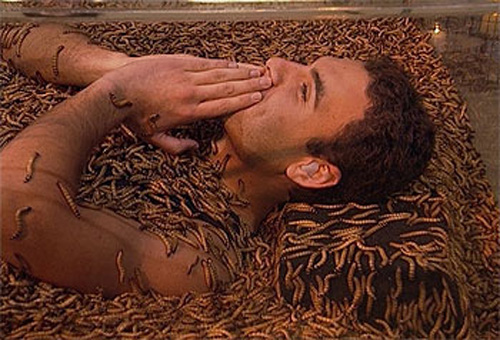 The people of the Amazon may not live longer than those living in the cities. Consuming large quantities of worms may be one of the reasons.
The people of the Amazon may not live longer than those living in the cities. Consuming large quantities of worms may be one of the reasons.
“When women of the Amazon insult their husbands, they say their man has a penis like a suri.” Oscar Ramirez, my guide with Peru Amazon Bike, hands me a skewer of suri (palm weevil larvae) at an Iquitos market. His description isn’t helping me take my first bite.
I really wanted to like larvae. European mealworm farmers declare entomophagy (insect eating) to be the way of the future, using all the popular catchphrases: responsible dining, sustainable farming, small footprint.
But is this just another opportunity for humans to bugger something up? The first website I opened regarding farming of mealworms advertised the use of hormones to make the mealworms bigger by stopping them from developing to adulthood. Instead, the baby beetles will keep growing in their larvae stage.
My imagination leaps from hormone-huge larvae to plagues of escaped, genetically modified, pesticide-resistant insects wiping out crops and forests.
If mankind doesn’t poison this opportunity, insects are a healthy dietary choice that could change the look of the food pyramid. Palm weevil larvae contain: iron, magnesium, calcium, zinc, potassium, plus protein and fat.
As I chew through the tough exterior of my charred larva, grub grease squirts into my mouth. Oscar looks at me eagerly. He makes me eat another, but I can now say that I don’t love larvae.
I love escargot, though admittedly it’s not the snail but the garlic butter. Billions of people around the world eat bugs, but if grubs are going to end up on mainstream menus beside escargot in North America and Europe, they need the affectionate attention of a culinary expert.
I asked Michael-Ann Rowe, host of Off the Beaten Palate (currently nominated for two Taste Awards), if she could connect me to the ultimate chef, who’d be up to the challenge of making Westerners drool for larvae. She immediately introduced me to Emmanuel Piqueras, celebrated Peruvian chef on both the East and West Coasts of the U.S. Piqueras is the executive chef who designed the menu at Panca in New York.
Piqueras grew up in Chorrillos, a fishing neighborhood in the south of Lima city. He says to me, “I believe you’ve had bad luck. The Amazon natives also eat suri alive for nutritional purposes.”Actually, maybe I’ve had good luck because my larvae were dead and not wriggling.
The picante Peruvian chef tells me, “You’ve had suri prepared in the traditional native way. But I have had chicharron de suri, marinated with garlic and salt and deep-fried in vegetable oil, which was very good. The best way to cook it is to wash it well, marinate with garlic puree and salt for 30 minutes or so, and then fry for a couple minutes until it becomes crunchy and golden. Or you grill them on skewers, marinate like anticuchos and grill for just five minutes.” Suri is starting to sound more appealing.
“If I was to cook suri at the restaurant in New York City, I would prepare it two ways: deep-fried or grilled, and served with chonta (hearts of palm) salad and hot sauces with aji-cocona and rocoto–camucamu.”
Now I’m salivating over suri … though preferably hormone-free because I don’t want to bite into a larva as big as a man’s penis.
Kirsten Koza is an author, humorist, foodie and adventurer.





2 Comments
Leave a Reply